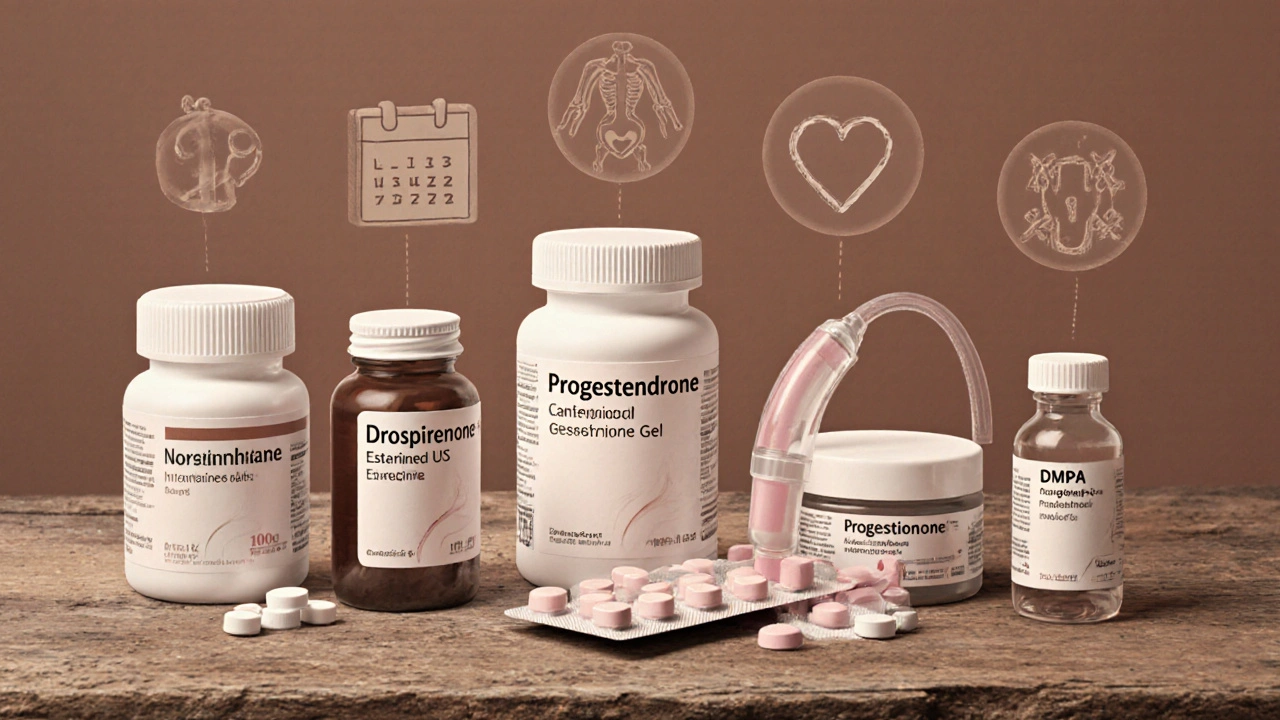Progesterone Medication Selector
Select Your Primary Indication
Preferred Dosing Convenience
Side Effect Tolerance
Budget Consideration
Recommended Progesterone Option
Why This Option?
When you or someone you care about needs a progesterone medication, the first name that often pops up is Provera (medroxyprogesterone acetate), a synthetic progestin used for everything from menstrual irregularities to hormone‑replacement therapy (HRT). But Provera isn’t the only game in town. This guide breaks down how Provera stacks up against the most common alternatives, so you can decide which option fits your health goals, lifestyle, and budget.
What is Provera and How Does It Work?
Medroxyprogesterone acetate is a synthetic version of the natural hormone progesterone. It binds to progesterone receptors in the uterus, breasts, and brain, telling the body to halt the lining buildup that would otherwise lead to a period. Because of this, doctors prescribe it for irregular periods, endometrial hyperplasia, and as part of HRT for menopause.
- Form: oral tablets (usually 2.5mg, 5mg, or 10mg) and a depot injection (200mg every 3 months).
- Typical uses: menstrual cycle regulation, treatment of abnormal uterine bleeding, contraception (injectable form), and menopause symptom relief.
- Onset: tablets start working within a few days; the injection can take up to two weeks for full effect.
Major Progesterone Alternatives on the Market
Here’s a quick snapshot of the most frequently asked‑about alternatives. Each belongs to the same family (progesterone or progestin) but differs in chemistry, side‑effect profile, and dosing convenience.
- Norethindrone: a first‑generation progestin taken daily in low doses (0.35mg‑5mg). Commonly used in combined oral contraceptives and for menstrual‑related conditions.
- Drospirenone: a newer progestin with anti‑androgen and mild diuretic effects. Available in combined pills (often paired with estradiol).
- Levonorgestrel: a potent progestin used in oral pills, emergency contraception, and intrauterine systems (IUS).
- Micronized progesterone: a bioidentical form of natural progesterone taken orally or vaginally, praised for a "more natural" feel.
- Depot medroxyprogesterone acetate (DMPA): the injectable version of Provera (often called Depo‑Provera), administered every 12 weeks.

Comparing Efficacy and Side‑Effect Profiles
Effectiveness depends on what you’re treating. Below is a high‑level comparison that highlights where each drug shines or falls short.
| Medication | Primary Indications | Typical Dose | Key Benefits | Common Side‑Effects |
|---|---|---|---|---|
| Provera (oral) | Irregular periods, endometrial hyperplasia, HRT | 2.5‑10mg daily | Strong control of uterine lining, convenient tablet form | Weight gain, bloating, mood swings |
| DMPA (injectable) | Contraception, menstrual suppression | 200mg IM every 12weeks | Very reliable birth control, no daily pill needed | Irregular spotting, bone‑density loss (long‑term) |
| Norethindrone | Menstrual regulation, endometriosis | 0.35‑5mg daily | Low dose, affordable | Nausea, breast tenderness |
| Drospirenone (combined) | Contraception, acne, PMDD | 3mg (combined with estradiol) | Anti‑androgen effects reduce acne, less water retention | Increased clot risk, potassium loss (rare) |
| Levonorgestrel (IUS) | Long‑term contraception, heavy bleeding | 20µg/day released locally | Minimally systemic, up to 5‑year use | Spotting initially, cramping |
| Micronized progesterone | HRT, luteal‑phase support | 100‑200mg oral or vaginal | Bioidentical, lower mood‑related side effects | Drowsiness, gastrointestinal upset |
Notice that the injectable form of Provera (DMPA) is the only option that offers a quarterly dosing schedule, which is a huge convenience for many people. On the flip side, long‑term use can affect bone health, so doctors usually recommend calcium and vitaminD supplements alongside it.
Dosing Simplicity and Lifestyle Fit
If you hate remembering a daily pill, injectable options (DMPA) or intrauterine systems (Levonorgestrel IUS) win hands down. Oral options like Provera, Norethindrone, and Micronized progesterone require strict adherence, but they let you stop the medication anytime without a medical procedure.
For women on HRT, combining a low‑dose estrogen with a bioidentical progesterone (micronized) often feels more “natural,” while Provera’s synthetic nature can cause more mood fluctuations in sensitive individuals.
Cost, Insurance Coverage, and Availability
Pricing varies by country and whether you have private insurance or Medicare‑eligible plans. In Australia, Provera tablets are listed on the Pharmaceutical Benefits Scheme (PBS) for specific indications, making them relatively cheap (around AUD12 per pack). The injectable DMPA isn’t PBS‑covered as often, leading to out‑of‑pocket costs of roughly AUD80‑120 per dose.
Micronized progesterone, especially the vaginal gel, tends to be pricier (about AUD50‑70 for a month’s supply) and may not be covered by PBS. Norethindrone tablets are generic and usually under AUD10 per month. Drospirenone combined pills are brand‑name and can run AUD30‑45 per pack unless subsidised.

How to Choose the Right Progesterone Option
Pick a medication based on three practical questions:
- What’s the primary reason you need a progestin? If it’s contraception, the injection or IUS may be best. For menstrual regulation, oral Provera or Norethindrone works well.
- How important is dosing convenience? Quarterly injections or a 5‑year IUS remove daily decisions, while oral pills let you pause quickly.
- What’s your tolerance for side‑effects? If you’re sensitive to weight gain or mood swings, micronized progesterone or drospirenone may be gentler.
Always discuss bone health, cardiovascular risk, and any existing medical conditions with your GP before locking in a long‑term plan.
Quick Comparison Checklist
- Provera (oral) - strong uterine lining control, daily pill, affordable via PBS.
- DMPA (injectable) - quarterly dosing, excellent birth control, possible bone‑density loss.
- Norethindrone - low‑cost, modest efficacy for bleeding issues, daily.
- Drospirenone - anti‑androgen, good for acne/PMDD, higher clot risk.
- Levonorgestrel IUS - 5‑year contraception, minimal systemic exposure, minor spotting.
- Micronized progesterone - bioidentical, fewer mood effects, pricier, flexible routes.
Frequently Asked Questions
Is Provera safe for long‑term use?
Provera is generally safe when prescribed for specific conditions, but long‑term daily use can increase the risk of weight gain, mood changes, and, in rare cases, cardiovascular issues. Regular check‑ups and blood‑pressure monitoring are recommended.
How does the injectable DMPA differ from the oral tablet?
The injectable DMPA releases the same hormone (medroxyprogesterone acetate) over three months, so you skip daily pills. However, because the hormone stays in your system longer, side‑effects like irregular spotting and potential bone‑density loss are more pronounced.
Can I switch from Provera to a bioidentical progesterone?
Yes, many doctors transition patients to micronized progesterone if mood or weight side‑effects become problematic. The switch usually involves a tapering period to avoid sudden hormonal gaps.
What should I do if I miss a Provera dose?
Take the missed tablet as soon as you remember, then continue with your regular schedule. If it’s close to the time of your next dose, skip the missed one-don’t double up. Always check the patient information leaflet for exact guidance.
Is there any interaction between Provera and common medications?
Provera can interact with certain anticonvulsants, antibiotics like rifampin, and herbal supplements such as StJohn’s wort, which may lower its effectiveness. Always list all your medicines to your prescriber.
Choosing the right progesterone therapy is a personal decision that balances effectiveness, side‑effects, cost, and lifestyle. Use the comparison table and checklist above as a starting point, then have an open conversation with your healthcare provider to tailor the plan to your unique needs.



Cynthia Sanford
Honestly, Provera can be a solid starter if you want that quick cycle control-no fancy dosing needed. It’s cheap, easy to find, and most insurance plans cover it. Just watch the mood swings, they can be a bit of a rollercoaster.